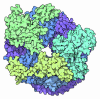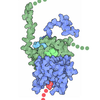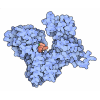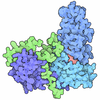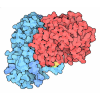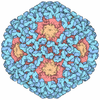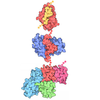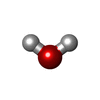+ Open data
Open data
- Basic information
Basic information
| Entry | Database: PDB / ID: 9e7u | ||||||
|---|---|---|---|---|---|---|---|
| Title | Cryo-EM structure of NOT1:NOT8:PieF | ||||||
 Components Components |
| ||||||
 Keywords Keywords | GENE REGULATION / PieF / mRNA decay / deadenylation / CCR4-NOT / host-pathogen interactions | ||||||
| Function / homology |  Function and homology information Function and homology informationpositive regulation of cytoplasmic mRNA processing body assembly / poly(A)-specific ribonuclease / poly(A)-specific ribonuclease activity / armadillo repeat domain binding / CCR4-NOT core complex / CCR4-NOT complex / miRNA-mediated gene silencing by mRNA destabilization / regulation of stem cell population maintenance / positive regulation of mRNA catabolic process / SUMO is conjugated to E1 (UBA2:SAE1) ...positive regulation of cytoplasmic mRNA processing body assembly / poly(A)-specific ribonuclease / poly(A)-specific ribonuclease activity / armadillo repeat domain binding / CCR4-NOT core complex / CCR4-NOT complex / miRNA-mediated gene silencing by mRNA destabilization / regulation of stem cell population maintenance / positive regulation of mRNA catabolic process / SUMO is conjugated to E1 (UBA2:SAE1) / SUMOylation of nuclear envelope proteins / SUMO is transferred from E1 to E2 (UBE2I, UBC9) / negative regulation of retinoic acid receptor signaling pathway / SUMO is proteolytically processed / nuclear-transcribed mRNA poly(A) tail shortening / SUMOylation of transcription factors / SUMOylation of transcription cofactors / Postmitotic nuclear pore complex (NPC) reformation / septin ring / SUMOylation of DNA damage response and repair proteins / negative regulation of intracellular estrogen receptor signaling pathway / Transcriptional and post-translational regulation of MITF-M expression and activity / trophectodermal cell differentiation / miRNA-mediated post-transcriptional gene silencing / SUMOylation of DNA replication proteins / Deadenylation of mRNA / nuclear retinoic acid receptor binding / SUMOylation of SUMOylation proteins / M-decay: degradation of maternal mRNAs by maternally stored factors / Recruitment and ATM-mediated phosphorylation of repair and signaling proteins at DNA double strand breaks / SUMOylation of RNA binding proteins / peroxisomal membrane / SUMOylation of chromatin organization proteins / nuclear-transcribed mRNA catabolic process, deadenylation-dependent decay / TP53 regulates transcription of additional cell cycle genes whose exact role in the p53 pathway remain uncertain / positive regulation of nuclear-transcribed mRNA catabolic process, deadenylation-dependent decay / positive regulation of nuclear-transcribed mRNA poly(A) tail shortening / ubiquitin-like protein ligase binding / protein sumoylation / nuclear estrogen receptor binding / condensed nuclear chromosome / P-body / protein tag activity / regulation of translation / 3'-5'-RNA exonuclease activity / molecular adaptor activity / negative regulation of translation / protein domain specific binding / positive regulation of cell population proliferation / negative regulation of transcription by RNA polymerase II / extracellular space / RNA binding / metal ion binding / identical protein binding / nucleus / membrane / cytosol Similarity search - Function | ||||||
| Biological species |  Homo sapiens (human) Homo sapiens (human) | ||||||
| Method | ELECTRON MICROSCOPY / single particle reconstruction / cryo EM / Resolution: 3.5 Å | ||||||
 Authors Authors | Levdansky, E. / Deme, J. / Lea, S.M. / Valkov, E. | ||||||
| Funding support |  United States, 1items United States, 1items
| ||||||
 Citation Citation |  Journal: Nat Commun / Year: 2025 Journal: Nat Commun / Year: 2025Title: Intracellular pathogen effector reprograms host gene expression by inhibiting mRNA decay. Authors: Yevgen Levdansky / Justin C Deme / David J Turner / Claire T Piczak / Filip Pekovic / Anna L Valkov / Sergey G Tarasov / Susan M Lea / Eugene Valkov /  Abstract: Legionella pneumophila, an intracellular bacterial pathogen, injects effector proteins into host cells to manipulate cellular processes and promote its survival and proliferation. Here, we reveal a ...Legionella pneumophila, an intracellular bacterial pathogen, injects effector proteins into host cells to manipulate cellular processes and promote its survival and proliferation. Here, we reveal a unique mechanism by which the Legionella effector PieF perturbs host mRNA decay by targeting the human CCR4-NOT deadenylase complex. High-resolution cryo-electron microscopy structures and biochemical analyses reveal that PieF binds with nanomolar affinity to the NOT7 and NOT8 catalytic subunits of CCR4-NOT, obstructing RNA access and displacing a catalytic Mg²⁺ ion from the active site. Additionally, PieF prevents NOT7/8 from associating with their partner deadenylases NOT6/6L, inhibiting the assembly of a functional deadenylase complex. Consequently, PieF robustly blocks mRNA poly(A) tail shortening and degradation with striking potency and selectivity for NOT7/8. This inhibition of deadenylation by PieF impedes cell cycle progression in human cells, revealing a novel bacterial strategy to modulate host gene expression. | ||||||
| History |
|
- Structure visualization
Structure visualization
| Structure viewer | Molecule:  Molmil Molmil Jmol/JSmol Jmol/JSmol |
|---|
- Downloads & links
Downloads & links
- Download
Download
| PDBx/mmCIF format |  9e7u.cif.gz 9e7u.cif.gz | 125.5 KB | Display |  PDBx/mmCIF format PDBx/mmCIF format |
|---|---|---|---|---|
| PDB format |  pdb9e7u.ent.gz pdb9e7u.ent.gz | 91.8 KB | Display |  PDB format PDB format |
| PDBx/mmJSON format |  9e7u.json.gz 9e7u.json.gz | Tree view |  PDBx/mmJSON format PDBx/mmJSON format | |
| Others |  Other downloads Other downloads |
-Validation report
| Summary document |  9e7u_validation.pdf.gz 9e7u_validation.pdf.gz | 1 MB | Display |  wwPDB validaton report wwPDB validaton report |
|---|---|---|---|---|
| Full document |  9e7u_full_validation.pdf.gz 9e7u_full_validation.pdf.gz | 1 MB | Display | |
| Data in XML |  9e7u_validation.xml.gz 9e7u_validation.xml.gz | 38 KB | Display | |
| Data in CIF |  9e7u_validation.cif.gz 9e7u_validation.cif.gz | 54.1 KB | Display | |
| Arichive directory |  https://data.pdbj.org/pub/pdb/validation_reports/e7/9e7u https://data.pdbj.org/pub/pdb/validation_reports/e7/9e7u ftp://data.pdbj.org/pub/pdb/validation_reports/e7/9e7u ftp://data.pdbj.org/pub/pdb/validation_reports/e7/9e7u | HTTPS FTP |
-Related structure data
| Related structure data |  47690MC 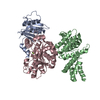 9e7tC M: map data used to model this data C: citing same article ( |
|---|---|
| Similar structure data | Similarity search - Function & homology  F&H Search F&H Search |
- Links
Links
- Assembly
Assembly
| Deposited unit | 
|
|---|---|
| 1 |
|
- Components
Components
| #1: Protein | Mass: 47754.742 Da / Num. of mol.: 1 Source method: isolated from a genetically manipulated source Source: (gene. exp.)  Homo sapiens (human) / Gene: SMT3, YDR510W, D9719.15, CNOT8, CALIF, POP2 / Production host: Homo sapiens (human) / Gene: SMT3, YDR510W, D9719.15, CNOT8, CALIF, POP2 / Production host:  References: UniProt: Q12306, UniProt: Q9UFF9, poly(A)-specific ribonuclease |
|---|---|
| #2: Protein | Mass: 16568.549 Da / Num. of mol.: 1 Source method: isolated from a genetically manipulated source Source: (gene. exp.)   |
| #3: Protein | Mass: 29237.787 Da / Num. of mol.: 1 Source method: isolated from a genetically manipulated source Source: (gene. exp.)  Homo sapiens (human) / Gene: CNOT1, CDC39, KIAA1007, NOT1, AD-005 / Production host: Homo sapiens (human) / Gene: CNOT1, CDC39, KIAA1007, NOT1, AD-005 / Production host:  |
| #4: Chemical | ChemComp-MG / |
| #5: Water | ChemComp-HOH / |
| Has ligand of interest | N |
| Has protein modification | N |
-Experimental details
-Experiment
| Experiment | Method: ELECTRON MICROSCOPY |
|---|---|
| EM experiment | Aggregation state: PARTICLE / 3D reconstruction method: single particle reconstruction |
- Sample preparation
Sample preparation
| Component | Name: NOT1:NOT8:PieF / Type: COMPLEX / Entity ID: #1-#3 / Source: RECOMBINANT |
|---|---|
| Source (natural) | Organism:  Homo sapiens (human) Homo sapiens (human) |
| Source (recombinant) | Organism:  |
| Buffer solution | pH: 7.5 |
| Specimen | Embedding applied: NO / Shadowing applied: NO / Staining applied: NO / Vitrification applied: YES |
| Vitrification | Cryogen name: ETHANE |
- Electron microscopy imaging
Electron microscopy imaging
| Experimental equipment |  Model: Titan Krios / Image courtesy: FEI Company |
|---|---|
| Microscopy | Model: TFS KRIOS |
| Electron gun | Electron source:  FIELD EMISSION GUN / Accelerating voltage: 300 kV / Illumination mode: FLOOD BEAM FIELD EMISSION GUN / Accelerating voltage: 300 kV / Illumination mode: FLOOD BEAM |
| Electron lens | Mode: BRIGHT FIELD / Nominal defocus max: 2500 nm / Nominal defocus min: 500 nm |
| Image recording | Electron dose: 52.4 e/Å2 / Film or detector model: TFS FALCON 4i (4k x 4k) |
- Processing
Processing
| EM software | Name: PHENIX / Category: model refinement | ||||||||||||||||||||||||
|---|---|---|---|---|---|---|---|---|---|---|---|---|---|---|---|---|---|---|---|---|---|---|---|---|---|
| CTF correction | Type: PHASE FLIPPING AND AMPLITUDE CORRECTION | ||||||||||||||||||||||||
| 3D reconstruction | Resolution: 3.5 Å / Resolution method: FSC 0.143 CUT-OFF / Num. of particles: 200675 / Symmetry type: POINT | ||||||||||||||||||||||||
| Refine LS restraints |
|
 Movie
Movie Controller
Controller




 PDBj
PDBj